
In excess of 1,200 attendees, 317 papers, 128 booths combined to make the 7th International Conference on Geosynthetics a fantastic success! In designing this conference the organizers set some unique goals. A significant focus was placed on the theme of technical, generational, cultural and industrial diversity – a somewhat risky but stimulating approach!
To achieve technical diversity the organizers assembled an extensive technical programme comprised of four tracks, each track tailored to a specific level of technical expertise. Papers were presented in a proceedings totalling 1,720 pages provided to all conference attendees on CD and available in hard copy.
 |
The ICG-7 organizers focused on involving the new generation of the geosynthetics community, with a strong emphasis on multi-cultural representation. Each of the four Keynote speakers was selected based on achieving this diversity. Each session included experts from different countries, of different ages and sometimes-different philosophies. The strong involvement of newcomers and new countries resulted in the initiation of at least 3 new IGS chapters in: Portugal, Slovakia and the Czech Republic with interest in chapters for Jordan, Malaysia,Iran and Scandinavia. Student sessions also received strong support from the conference planners, J.P. Gourc and Philippe Delmas both expressed a keen interest in providing experience, encouraging new ideas and fostering a strong relationship between the industry and its students – as a result a strong student programme emerged. Student Awards were presented each to a student from a different IGS Chapter. (Complete list of student awards) The IGS provided $1,000 to each of the students to assist them with attending the conference. |
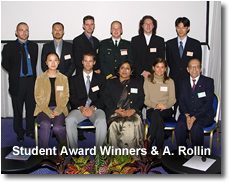 |
Conference planners worked at forging new relationships to serve the geosynthetic industry’s technical and business expansion by actively seeking members of geosynthetics related industries to participate in the conference. Every session included one participant from a related industry or association. This strategy provided attendees a forum within which to establish new contacts and explore opportunities with those related industries.
| The opening session on Sunday afternoon was amazingly well attended, and all those who forsook the beaches and the Nice International Triathlon were treated to Kerry Rowe of Queens University, Canada, presenting the IGS’s second Giroud Lecture "Geosynthetic-Reinforced Embankments Over Soft Foundations" in his inimitable easy-to-listen-to but hard-hitting you’d-better-understand-this style. We heard that reinforcement substantially increases the failure heights of embankments on both rate sensitive and insensitive soils. The increase in stability by using stiff geogrids under partially drained conditions, compared to undrained conditions, was noted, therefore the use of prefabricated vertical drains (PVDs) is very beneficial. Such an approach can significantly shorten embankment construction times, thus tying theoretical studies to field practices. |
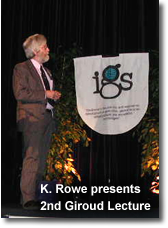 |
There were an unprecedented four technical tracks presented: Landfill, Damage to Geosynthetics, Filtration, and Modelling of Soil/Geosynthetic Interaction, an assortment of information ranging from theoretical to practical, once again living up to 7ICG’s emphasis on diversity.
 |
 |
The Exhibition hall was a constant hub of activity. One hundred and twenty eight booths were filled, exceeding expectations by 18-28 booths. The floor of the exhibition stayed busy for the duration of the conference – as a member of the press I had difficulty getting to speak to some vendors because they were so busy!
For the first time sponsored technical sessions were created as a new way to bring together education, technology and business. One ½-hour session per day was offered in this category. Each sponsored technical session was presented by a company with a cutting edge technology or service. Organizers report that response from attendees was very strong in these sessions – establishing a basis for expansion of sponsored sessions at future conferences.
|
Awards were presented to members of the community for outstanding contributions to the geosynthetics industry included in these awards were: 7ICG marks the first time an IGS Award has been presented to a corporation; Colbond Geosynthetics earned this award for its dedication to long-term research into high modulus polyester soil reinforcement materials. |
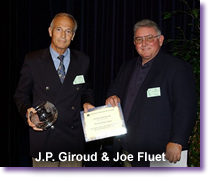 |
Behind the scenes there was an incredible bustle of energy – the conference organizers worked very hard at utilizing as much available technology as possible. Beginning with solicitation and submission of abstracts and papers this organizing committee used electronic transmission of materials. Review of the materials was also handled electronically – each member of the technical committee was provided a log-in and password allowing them to review papers and notes from other technical reviewers. A very useful website was designed for use by the public for: registration, accommodation, companion programmes, and technical programme information. Everything in its entirety was posted to the site, updated frequently and organized well.
At the Acropolis the scientific desk was comprised of a team of professionals and students. The Scientific desk reviewed each presentation, ensuring its compliance with standards set by the technical committee. The Scientific Team then assembled then presentations to the specification of each Session Chair. Each Session Chair was also provided an assistant from the Scientific Desk, to help manage the presentations during the session. This system, by all reports, ran smoothly.
The Ordinary General Assembly was convened on the final evening of the conference. Included in the business at hand were reports from: the treasurer, the secretary the president and the financial committee. All news was positive, IGS is in solid financial shape. A reccomendation was made to incresase spending. D. Cazzuffi was elected Presiden, F. Tatsuoka was elected Vice President. For complete reports se
e the IGS Web Site www.geosyntheticssociety.org (links to these reports will be listed on the front page of geosynthetics society web site). The General Assembly also included the announcement of the 8 council positions, and officers. The newly elected IGS Council members are: G. Bräu, S. Corbet, P. Delmas, M. Maugeri, H. Miki, E. Palmeira, P. Stevenson, W. Voskamp. Returning members include: J. Cowland, D. Fettig, V. Feodorov, M. Kamon, J. Lafleur, E.S. Lee, M. Lopes, B. Myles, J. Paul, M. Sadlier, P. Jarrett, E. Leflaive, B. Myles, P. Rankilor, H. Schneider, D.B. Sweetland, C. van den Berg, K. van Harten.
Elected Officers: President: Daniele Cazzuffi;Vice President: Fumio Tatsuoka; Secretary: Peter Stevenson;Treasurer: Philippe Delmas; and Immediate Past President: Richard Bathurst.
 |
I would be remiss if I did not mention the 7ICG extracurricular activities. The conference began on Sunday with a shotgun start, a Mini-Marathon. The marathon was created in the spirit of the ITU Long Distance World Championships and the 21st International Triathlon of Nice being held the same day. Tuesday evening was to hold 2 sporting events – the traditional Football Mach and a Petanque Tournament. An extraordinarily rare September hailstorm separated the real sportsmen from the more casual participants. The football players, and a select few fans, proved their resolve by continuing on with the game despite many obstacles. The football participants were divided into two teams the Latin Team and the Anglo Team, the Latin Team prevailed 6 – 5. The less persistent but possibly wiser Petanque group opted out of sport (and hail) – most continued on with yet another evening of good food and wine in beautiful Nice. |
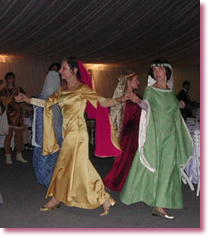 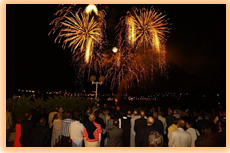 |
The Grand Finale was all that a Grande Finale should be! The location was kept a mystery until attendees’ arrival by coach at the Citadel. Located on the eastern side of Nice the Citadel is an impressive structure. The walled city was built over 600 years ago with an extraordinary history and truly beautiful architecture (not a single geosynthetic to be found!). The Citadel is built into the side of a large hill with a view of the Mediterranean revealing the best that Nice has to offer. In keeping with the ambiance, the 5 course meal was superb. Medieval costumed entertainers preformed throughout the aisles: jugglers, magicians, musicians, acrobats and others kept us enchanted throughout dinner. At the conclusion of the meal a dramatic fireworks performance over the Mediterranean had all of us mesmerized. All of the entertainment that was provided however did not measure up to the outstanding performance by our geosynthetic brethren on the moonlit courtyard dance floor! |












